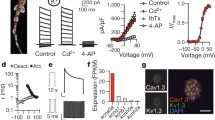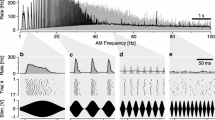Summary
Directionality of response in the statocyst receptors of the crayfish (Procambarus clarkii Girard) was investigated by artificially deflecting individual statocyst hairs in various directions.
-
1.
The hairs attached to the receptors are aligned in a crescent on the statocyst floor. Hair deflection toward the center of the crescent elicited maximal excitatory responses in the majority of the receptors. Hair deflection in the opposite direction elicited maximal suppressive responses.
-
2.
It was concluded that most of the statocyst receptors are functionally polarized toward the center of the crescent. The plane of functional polarization was consistent with that of morphological polarization.
-
3.
The receptors could be classified into two types; tonic (42%) and phasic (50%), according to the time course of the excitatory responses. The remainder (8%) could not be classified as either of these, showing intermediate responses.
-
4.
Some (ca. 40%) of the phasic-type receptors responded transiently regardless of the direction of hair deflection. It is suggested that the role of those receptors without any plane of functional polarization, is different from that of the other receptors in producing equilibrium responses.
Similar content being viewed by others
References
Cohen, M.J.: The function of receptors in the statocyst of the lobsterHomarus americanus. J. Physiol.130, 9–34 (1955)
Cohen, M.J.: The response pattern of single receptors in the crustacean statocyst. Proc. R. Soc. Lond. Biol.152, 30–49 (1960)
Flock, Å.: Sensory transduction in hair cells. In: Handbook of sensory physiology, Vol. I. Principles of receptor physiology. Loewenstein, W.R. (ed.), pp. 396–441. Berlin, Heidelberg, New York: Springer 1971
Hensen, V.: Studien über das Gehörorgan der Decapoden. Z. Wiss. Zool.13, 319–412 (1863)
Higuchi, Y., Hisada, M.: Visual and geotactic contribution to oculomotor responses in the crayfish,Procambarus clarkii. J. Fac. Sci. Hokkaido Univ. Ser. VI, Zool.18, 495–506 (1973)
Hisada, M.: Structural and functional polarization of the statocyst hairs of crayfish, (in Japanese). J. Physiol. Soc. Japan37, 292 (1975a)
Hisada, M.: Gravitational and visual control of eye movement in crayfish. Fortschr. Zool.23, 162–173 (1975b)
Hisada, M., Higuchi, T.: Basic response pattern and classification of oculomotor nerve in the crayfish,Procambarus clarkii. J. Fac. Sci. Hokkaido Univ. Ser. VI, Zool.18, 481–494 (1973)
Hisada, M., Sugawara, K., Higuchi, T.: Visual and geotactic control of compensatory eyecup movement in the crayfish,Procambarus clarkii. J. Fac. Sci. Hokkaido Univ. Ser. VI, Zool.17, 224–239 (1969)
Kinzig, C.H.: Untersuchungen über den Bau der Statocysten einiger decapoden Crustaceen. Verh. Naturf.-Med. Ver. Heidelberg, N.F.14, 1–90 (1919)
Lindeman, H.H.: Studies on the morphology of the sensory regions of the vestibular apparatus. Ergebn. Anat. Entwickl. Gesch.42, 1–113 (1969)
Mellon, DeF.: The anatomy and motor nerve distribution of the eye muscles in the crayfish. J. comp. Physiol.121, 349–366 (1977)
Ozeki, M., Takahata, M., Hisada, M.: Afferent response patterns of the crayfish statocyst with ferrite grain statolith to magnetic field stimulation. J. comp. Physiol.123, 1–10 (1978)
Panning, A.: Die Statozyste vonAstacus fluviatilis (Potamobius astacus Leach) und ihre Beziehung zu dem sie umgebenden Gewebe. Z. Wiss. Zool.123, 305–358 (1924)
Patton, M.L.: Physiological evidence indicating that decapod statocyst hairs drive three sensory neurons. Am. Zool.9, 1097 (1969)
Prentiss, C.W.: The otocyst of decapod crustacea. Bull. Mus. Comp. Zool. Harvard36, 167–254 (1901)
Rath, O. vom: Zur Kenntnis der Hautsinnesorgane der Crustaceen. Zool. Anz.14, 195–214 (1891)
Sandeman, D.C., Okajima, A.: Statocyst-induced eye movements in the crabScylla serrata. I. The sensory input from the statocyst. J. Exp. Biol.57, 187–204 (1972)
Schöne, H.: Die statische Gleichgewichtsorientierung dekapoder Crustaceen. Verh. Dtsch. Zool. Ges.16, 157–162 (1951a)
Schöne, H.: Die Arbeitsweise der Statocyste vonAstacus fluviatilis. Naturwissenschaften38, 157 (1951b)
Schöne, H.: Statocystenfunktion und statische Lageorientierung bei dekapoden Krebsen. Z. vergl. Physiol.36, 241–260 (1954)
Schöne, H.: Gravity receptors and gravity orientation in crustacea. In: Gravity and the organisms. Gordon, S.A., Cohen, M.J. (eds.), pp. 223–235. Chicago, London: University of Chicago Press 1971
Schöne, H.: On the transformation of the gravity input into reactions by statolith organs of the ‘fan’ type. Fortschr. Zool.23, 120–128 (1975a)
Schöne, H.: Orientation in space: Animals. In: Marine ecology II. Physiological mechanisms. Kinne, O. (ed.), pp. 499–553. London: Wiley Sons (1975b)
Schöne, H., Steinbrecht, R.A.: Fine structure of statocyst receptor ofAstacus fluviatilis. Nature220, 184–186 (1968)
Stein, A.: Attainment of positional information in the crayfish statocyst. Fortschr. Zool.23, 109–119 (1975)
Sugawara, K., Hisada, M., Higuchi, T.: Eyestalk musculature of the crayfish.Procambarus clarkii. J. Fac. Sci. Hokkaido Univ. Ser. VI, Zool.18, 45–50 (1971)
Takeuchi, A., Takeuchi, N.: The effect on crayfish muscle of iontophoretically applied glutamate. J. Physiol.170, 296–317 (1964)
Author information
Authors and Affiliations
Additional information
This paper is dedicated to the memory of the late Professor Mituo Tamasige of the Zoological Institute, Faculty of Science, Hokkaido University. We are grateful to Prof. S.Y. Botelho for reading the manuscript and for constructive suggestions. We thank Dr. Minoura for the use of the scanning electron microscope. Supported by research grants Nos. 154238 and 284027 from the Ministry of Education in Japan to MH.
Rights and permissions
About this article
Cite this article
Takahata, M., Hisada, M. Functional polarization of statocyst receptors in the crayfishProcambarus clarkii Girard. J. Comp. Physiol. 130, 201–207 (1979). https://doi.org/10.1007/BF00614606
Accepted:
Issue Date:
DOI: https://doi.org/10.1007/BF00614606




